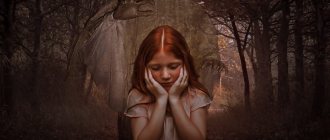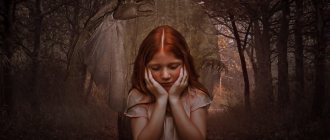Both in the distant past and in the present time, people experienced fear. Sometimes it has its own reason, it is completely natural, and sometimes it interferes with life and significantly harms health.
If the fear is far-fetched, of a pathological nature, then it is usually called a phobia - a much deeper condition that does not allow one to live fully. Phobias are accompanied by hallucinations, delusions, and cause nightmares and other destructive manifestations of the psyche. They can appear since childhood, and then transform and turn into other forms of fears.
Types of fears
At the current period of scientific development, scientists have identified about 400 types of fears. There are also a large number of classifications.
Karvasarsky identifies types of phobias based on their causes:
- Sexual phobias.
- Phobophobias are fears based on the sensations themselves.
- Thanatophobia - fear of death.
- Fear of experiencing cognitive dissonance - doing something out of the ordinary, violating the usual understanding, upbringing, breaking the law.
- Claustrophobia, agoraphobia - fear of closed spaces and other types.
- Nosophobia - fears of becoming infected or getting sick, are especially pronounced during periods of epidemics and infections.
- Fears of harming yourself or others.
- Social phobias. This is a large group of fears of interacting with people and society, building relationships with loved ones.
There is also a classification of fears depending on the patient’s age and role:
- Children's. Such phobias are based on the feeling “I am part of the environment.” These are fears of the dark, creatures from fairy tales, spiders, shadows. There are also social phobias, which then progress into adulthood.
- Teenage. This type is based on the feeling “I am the environment.” These are fears of death, infection, sexual intimacy, spatial ones.
- Parental. The parent gives himself excessive responsibility for the children, which is why he develops an obsessive feeling of insecurity and expectation of the worst.
Fear is the strongest human emotion that cannot be controlled. A person is afraid of both something traditional, obvious, and absolutely amazing things and phenomena.
We present phobias in list form, each of which in one way or another affects the mental health of the individual.
Fear of mice and rats
Various types of fears develop in 14% of people at one stage or another in life. They can be harmless or cause health problems. Inspired phobias are considered the most dangerous. Suspicious people are more susceptible than others to the fear of getting sick. It is called pathophobia, or nosophobia. Severe fear can cause imaginary pain. Sometimes you can get out of this state only with the help of antidepressants. Nosophobes, getting rid of a non-existent disease, tend to self-medicate and this can seriously harm their health.
Phobias are studied by doctors, biologists, psychologists, philosophers, theologians, and linguists, each presenting them in their own way with many comments related to their profession.
There are fears caused by animals - zoophobia. People experience fear of various animals: spiders, cockroaches, snakes, dogs, cows, but most often mice (musophobia) and rats (zemmiphobia).
If the fear has gone very far, a person becomes sick from the sight of not only living rodents, but even Mickey Mouse, depicted in drawings, in the form of figurines or on a T-shirt. Zemmyophobia includes the fear of rats and moles. It may be caused by disgust at the sight of these animals. Zemmyophobes believe that they are planning an attack and will attack at any moment. Scientists believe that the fear of mice has long been passed down from generation to generation at the genetic level, as a warning about the danger of losing food supplies and contracting diseases.
Classification
Sexual phobias
- Philophobia – fear of falling in love, experiencing a strong feeling;
- Oneirogmophobia – fear of night ejaculation;
- Gamophobia – fear of getting married, entering into a legal union;
- Contreltophobia – fear of sexual violence;
- erotophobia – fears about intimacy;
- Virginitiphobia – fear of being raped;
- Cypridophobia – fear of prostitutes, fear of contracting a sexually transmitted disease;
- Philemaphobia – fear of kissing;
- Primeisodophobia – fear of losing innocence.
Fears related to the human body
- Phalacrophobia – fear of hair falling out;
- odontophobia – fears about any manipulation of teeth and visits
- dental office;
- euphobia (Gertuphobia) – fear of one’s own and others’ knees;
- Levophobia – fear of body parts located on the left;
- dextrophobia (Oextro phobia) – fear of body parts located on the right;
- medomalacuphobia – fear of losing potency;
- Chirophobia - unpleasant sensations due to someone else's hands;
- Ommetaphobia – anxiety about looking into another person’s eyes;
- Gymnophobia – fear of the sight of a naked body;
- Rhytiphobia – fear of wrinkles;
- dysmorphophobia – fear of flaws in one’s body;
- Chaetophobia – fear of any hair;
- Medorthophobia – fear of the male genital organ;
- Osmophobia – fear of body odors;
- Hemophobia – aversion to blood.
Concerns about specific locations
- Scolinophobia – rejection from school;
- Gephyrophobia – fear of being on a bridge;
- nosocomephobia – fears about staying in medical institutions;
- Eicophobia – fear of being at home;
- Batophobia – fear of elevated buildings;
- lygrophobia (Lygophobia) – neurosis due to a darkened room, poorly lit areas;
- Ecclesiophobia – worries about church organizations;
- topophobia – neurosis in specific objects;
- Domatophobia – neurosis due to all the buildings in a row;
- Theatrophobia – serious worries about theater performances or the theater stage;
- Atephobia – fear of destroyed houses and buildings;
- Nyctohylophobia – fear of dense, gloomy forests;
- Koinoniphobia – worries about being in any room;
- Hagiophobia - neurosis due to religious rituals and ceremonies, shrines, clergy.
Phobias due to natural phenomena
- Scotophobia – neurosis due to darkness;
- Auroraphobia – fear of the northern lights;
- Cremnophobia - neuroses due to an abyss, abyss, ravine, slope;
- Nephophobia – dislike of clouds;
- sciopophobia – fear of shadows;
- Homichlophobia – neurosis in front of fog;
- Lilapsophobia – experiences before a hurricane, storm;
- Chionophobia – fear of snow cover;
- Ancraophobia – neurosis due to drafts and wind;
- Ligyrophobia – fear caused by sharp sounds;
- Nyctophobia - neurosis in front of the night, a dark room;
- acrophobia – fear of being above the ground;
- Ombrophobia – fear of heavy rain;
- Brontophobia – fear caused by lightning and thunderstorms;
- anemophobia – fear that arises due to significant air gusts or storms;
- Cryophobia is a neurosis due to the coming frosts in winter.
Fear of color
- Chromophobia – a neurotic condition due to all shades and colors;
- Leukophobia – a neurotic condition due to the color white;
- porphyrophobia – a neurotic condition due to the color purple;
- xanthophobia (Xanlhophobia) – a neurotic condition due to the color yellow;
- erythrophobia (Erythrophobia) – a neurotic condition due to the color red;
- Melanophobia (Metanophobia) is a neurotic condition due to the color black.
Social phobias
- Isolophobia – fear of being alone;
- Teleophobia – neurosis due to religious rituals, religion itself;
- Katagelophobia – fear of being ridiculed;
- Deipnophobia – worries about upcoming conversations at the table during meetings with guests;
- Athazagoraphobia – fear of being unnoticed and ignored;
- Enissophobia – neurosis due to criticism;
- Ochlophobia – fear of crowds;
- aphenphosmophobia - neurosis from other people's touches;
- Liticaphobia – fear of legal proceedings, exposure;
- scoptophobia – excessive isolation, fear of being funny in the opinion of others;
- Eupophobia – fear of receiving positive news.
Fear of insects
- Arachnephobia – neurosis due to a spider;
- parasitophobia (Parasitophobia) – a neurotic state due to a parasitic insect, hostility to bedbugs and lice;
- Myrmecophobia – dislike of ants;
- Acarophobia – neurosis due to insects and ticks;
- Mottephobia – dislike of moths;
- Apiphobia – neurosis due to the expectation of getting a bee sting.
Phobias due to numbers
- Octophobia – fear of the number 8;
- Triskadekaphobia – neurosis due to the number 13;
- Numerophobia – worries about every number.
Phobias associated with death
- Thanatophobia - neurosis about the thought of one’s sudden death and funeral;
- Coimetrophobia – neurosis due to the cemetery;
- Sellophobia – fear of the processes that occur with the body after burial;
- necrophobia - neurosis due to funeral rites, fear of the dead;
- Taphephobia – fear of being buried alive;
- plakophobia (Ptacophobia) – neurosis due to gravestones.
Fear of space
- Stenophobia – avoidance of narrow, cramped corridors;
- Aeroacrophobia – neurosis due to high open areas;
- Spacephobia – neurosis due to empty rooms, emptiness;
- Agoraphobia – fear of open spaces;
- Cenophobia – worries about empty rooms;
- Agyrophobia – panic in front of the road and streets;
- Claustrophobia – terror in a confined space.
Phobias in front of abstract concepts:
- Technophobia – electronic devices and new technologies cause horror;
- logophobia (Logophobia) – neurosis when it comes to the need to speak out;
- dikephobia (Dikepbobia) – fear that the truth will be restored;
- hylephobia (Hylepnobia) – neurosis due to materialism;
- apeirophobia - neurosis due to infinity, limitlessness of space;
- Ideophobia – fears due to thoughts;
- psychophobia (Psychophobia) – hostility towards the mentally ill;
- symmetrophobia – neurosis due to symmetry;
- allodoxaphobia – neurosis due to other people’s opinions;
- heresyphobia – unconventional ideas cause panic;
- Ouranophobia – fear of looking at the sky;
- Melophobia – neurosis due to loud music;
- Satanophobia – fear of evil spirits, evil, the coming of the devil;
- Mythophobia - experiences due to traditions, myths, legends;
- Cainophobia – fears about everything new: things, feelings;
- Gnosiophobia (Gnosiophobta) – new knowledge and information causes panic;
- Philosophobia – neurosis due to philosophical ideas;
- metrophobia – poetry causes horror;
- Hadephobia – fear of going to hell;
- prosophobia (Prosophobta) – worries about progress;
- Theologicophobia – religious teachings cause stress;
- demonophobia (Demonophobia) – worries about demons, evil spirits;
- phasmophobia (Phasmoprtobia) – neurosis due to ghosts, ghosts;
- Nomatophobia – fear of calling someone by name;
- Hellenologophobia – a neurotic condition due to the presence of scientific terms;
- Theophobia - fear of receiving divine punishment, a fateful blow, punishment from religion, God;
- Symbolophobia – fear of symbols, phenomena, objects, events, prophetic dreams and omens.
Phobias of people of other nationalities
- Teutophobia – neurosis due to Germans, Germany and everything German;
- Japanophobia - neurosis due to the people of Japan and everything Japanese;
- Heliophobia – neurosis due to Greece, Greek traditions;
- Russophobia – neurosis due to Russia and everything Russian;
- Judeophobia – neurosis due to Jews and everything Jewish;
- Anglophobia – neurosis due to Great Britain as a whole;
- Francophobia - neurosis due to the inhabitants of France and everything French;
- Sinophobia – neurosis due to the people of China and everything Chinese;
- xenophobia – fear of representatives of a different religion, cultural development,
- states and nations.
Fear of fauna inhabiting water bodies
- Ichthyophobia – fish make you nervous;
- selachophobia (Selachophobta) – panic about sharks;
- Bufonophobia – dislike of toads;
- Ophidiophobia – dislike of reptiles;
- scoleciphobia – dislike of worms;
- herpetophobia – dislike of snakes and lizards;
- Batrachophobia – dislike of frogs;
- Ostraconophobia – dislike of shellfish.
Phobias due to others
- Teratophobia – people with an underdeveloped physical appearance, freaks cause panic and fear that a sick child will be born;
- Wiccaphobia – worries about sorcerers and witches;
- harpaxophobia – fear of being robbed, neurosis due to thieves;
- Pogonophobia – a person with a beard is terrifying;
- Gynophobia – dislike of ladies;
- androphobia - dislike of gentlemen;
- heterophobia (Heterophobia) – avoidance of people of the opposite sex;
- Peladophobia – people with shaved skulls are terrifying;
- Eisoptrophobia – neurosis due to one’s own mirror image;
- parthenophobia (Parthenophobia) – neurosis due to a chaste girl;
- Dentophobia – neurosis due to dental treatment, fear of the dentist;
- Hobophobia – people in distress cause panic;
- Coulrophobia (Coulrophobla) – clowns make you nervous;
- Anthropophobia – neurosis due to all people in general;
- Syngenesophobia – fears due to the presence of a loved one;
- Homophobia – homosexuals make people nervous;
- politicophobia (Politicophobia) – anxiety due to being next to a person from the political sphere;
- ephebiphobia – makes young people and teenagers nervous;
- Pedophobia – dislike of a child;
- gerontophobia (Gerontophobia) – old people and elderly people are afraid of it;
- Pentheraphobia – makes the mother-in-law or mother-in-law nervous.
Animal concerns
- Lutraphobia – makes otters nervous;
- Alektorophobia – roosters and hens make you nervous;
- Ornithophobia – birds make you nervous;
- doraphobia – wool and fur cause panic;
- Cynophobia – dogs make you nervous;
- aclurophobia – makes cats nervous;
- Taurophobia – cows and bulls make you nervous;
- Zemmiphobia – makes rats nervous;
- musophobia – neurosis due to the mouse;
- Hippophobia – dislike of horses;
- agrizoophobia – fear of street and forest animals;
- Zoophobia - fear of all representatives of fauna.
Phobias caused by food
- Oenophobia – neurosis due to the type of wine;
- Lachanophobia – neurosis due to vegetables;
- Cibophobia – fear of eating;
- Carnophobia – intolerance to meat products;
- Alliumphobia – neurosis due to garlic;
- Methyphobia – experiences due to alcoholic beverages.
Fears of doing certain activities
- Ergophobia – neurosis due to performing work that requires special knowledge and experience;
- dipsophobia – fear of drinking any liquid;
- macrophobia (Macrophobia) – neurosis due to expectation of something;
- Vestiphobia – fear of choosing clothes for certain purposes, wearing them under weather conditions;
- Phronemophobia – fears due to the need to think;
- agyrophobia - neurosis due to the need to cross a street or highway;
- Mageirocophobia – neurosis due to cooking;
- Hodophobia – fear of traveling, making a trip;
- Paralipophobia – fear of not doing what was promised, of failing;
- graphophobia - fear of writing something;
- phonophobia – fear of making a phone call;
- Glossophobia – fear of speaking in front of crowds of people;
- optophobia (Optophobia) – fear of seeing something repulsive, hostile, being scared;
- Kleptophobia – fear of stealing something;
- Enosiophobia – fear of breaking religious commandments, sinning;
- Cyberphobia – fear of computer technology;
- Somniphobia – fear of falling asleep;
- Katisophobia – fear of sitting down;
- Ergasiophobia – worry about a planned action or behavior;
- Doxophobia – fear of voicing one’s position;
- Ambulophobia – fear of walking;
- Maleusiophobia – neurosis due to the onset of labor and contractions;
- Pharmacophobia – fear of taking medications;
- Chorophobia – fear of performing dance movements;
- amaxophobia – fear of driving;
- Tropophobia – fear of moving to another apartment and the associated changes;
- Clinophobia – fear of falling asleep;
- urophobia – fear of urinating in the wrong place;
- Decidophobia – fear of deciding something;
- Kinetophobia – fear of movement;
- Laliophobia – neurosis before speaking;
- Sophophobia – neurosis due to studying, visiting educational institutions;
- Abultophobia – neurosis due to washing, bathing, and performing water procedures;
- nostophobia – fear of returning home;
- Dishabillophobia – neurosis due to public nudity or removal of an item of clothing.
Phobias due to specific objects
- Motorophobia – fear of cars and driving them;
- Crystallophobia – fear of glass and crystal products;
- Aichmophobia – fear of cutting and piercing objects, needles, knives and pointed parts;
- Chrometophobia – fear of money;
- Bibliophobia – fear of reading books;
- siderodromophobia - fear of trains;
- Aerophobia – fear of flying on airplanes;
- pediophobia (Pediophobia) - neurosis due to life-size figures, dolls, wax figures - objects depicting a model of a person;
- Hoplophobia – fear of bladed weapons and firearms;
- Telephonophobia – fear of using the telephone;
- Ballistophobia – fear of bombs, shells, bullets, rockets, throwing objects;
- Microphobia – fear of small details;
- Textophobia – fears about fabrics and textiles;
- Enetophobia – fear of piercing objects, pins, etc.;
- neopharmaphobia – fear of taking new medications;
- Cyclophobia – fear of bicycles, two-wheeled mode of transport;
- asymmetriphobia – fear of objects with asymmetry;
- nucleomituphobia (IMucleomituphobia) – fears due to threats of nuclear war, the use of nuclear weapons;
- Mechanophobia – fear of mechanical objects, machines;
- Papyrophobia – fear of paper, clean and wet, dirty;
- Xyrophobia – fear of razors;
- Chronometrophobia – fear of clock mechanisms, the passage of time;
- Megalophobia – fear of huge objects;
- Cyberphobia – fear of electronic equipment, computers.
Fears due to sunlight or other light
- Photophobia – intolerance to any light sources;
- Electrophobia – fear of the electrical system;
- xerophobia – fear of deserts, dry climates;
- Selaphobia – fear of a sharp flash of light;
- photoaugliaphobia (Photoaugliaphobia) – fear of strong lighting;
- Heliophobia – fear of direct exposure to sunlight;
- Eosophobia – fear of dawn, the beginning of a new day;
- Phengophobia – fear of objects that shine from the sun's rays.
Phobias before an emergency
- Rhypophobia – fear of dirt, lack of cleanliness, pollution;
- hypnophobia (Hypnopliobia) – fear of sleeping due to fear of dying;
- Pnigophobia – fear of suffocation;
- Mastigophobia – neurosis due to corporal punishment, spanking;
- Anginophobia – fear of angina, suffocation or choking;
- Rhabdophobia – fear of physical or mental punishment;
- Dystychiphobia – fear of accidental tragedy;
- tomophobia – neurosis due to the likelihood of surgical intervention;
- Atomosophobia – fear of a nuclear explosion;
- Merinthophobia – neurosis due to rope;
- Radiophobia – fear of receiving radioactive radiation.
Neurosis due to certain conditions
- Atychiphobia – fear of failure;
- Zelophobia – fear of jealousy;
- cherophobia – neurosis due to the upcoming fun;
- Dinophobia – fear of dizziness and nausea;
- Menophobia – fear of menstruation and accompanying pain;
- Atelophobia – fear of not conforming to perfection, ideal;
- Mnemophobia – fear due to past events;
- eleutherophobia (Eleutherophobta) – neurosis due to freedom;
- Hypengyophobia – fear of unnecessary responsibility;
- obesophobia – fears of being overweight;
- asthenophobia – fear of losing strength, energy, being weak;
- Leniaphobia (Peniaphobia) – fear of becoming poor;
- Plutophobia – fear of getting rich;
- Angrophobia – fear of experiencing and receiving rage and anger from others;
- Soteriophobia – fear of being dependent on others;
- Doxophobia – fear of expressing gratitude, expressing your opinion;
- Illyngophobia – fear of feeling dizzy if you look down;
- monophobia – fear of being alone;
- gerontophobia – neurosis due to old age and accompanying weaknesses and illnesses;
- Oneirophobia – fear of dreaming;
- Hedonophobia - neurosis due to receiving pleasure, pleasure, joy;
- Kopophobia – fear of overwork;
- alginophobia (Algiophobia) – fear of experiencing pain;
- Hormephobia – neurosis due to random stress and the appearance of shock.
Phobias of certain substances
- Iophobia (iophobia) – fear of poisoning from poison;
- Seplophobia – neurosis due to rot;
- aurophobia – fear of gold and products made from it;
- metallophobia – neurosis due to metal and objects made from it;
- amatophobia (Amathophobia) – fear of dusty surfaces, constant cleaning;
- Coprophobia – fear and aversion due to feces.
Water fears:
- Potamophobia - neurosis due to river flows, waterfalls;
- Antlophobia – fears due to the risk of floods;
- Thalassophobia – neurosis due to bathing, swimming in the oceans, seas;
- hydrophobia (Hydrophobia) – neurosis due to water, approaching a body of water, the occurrence of convulsive movements when swallowing;
- Limnophobia – neurosis due to the depth of lakes.
Fear of the forest or nature:
- Dendrophobia – neurosis due to a large number of trees;
- Anthrophobia – neurosis due to flowers;
- Mycophobia – fear of being poisoned by mushrooms;
- hylophobia (Hyiophobia) – neurosis due to forests;
- Olfactophobia – fear of smells;
- Botanophobia – neurosis due to flora.
Phobias before illnesses
- Cardiophobia – fear of having a heart attack, heart disease;
- Dementophobia – fear of clouding of mind, madness;
- Toxicophobia – fear of getting poisoned, intoxicating the body;
- amnesiphobia – fear of losing memory;
- paraphobia – fear of deviations in sexual development;
- Luiphobia – fear of contracting syphilis;
- Diabetophobia – fear of diabetes;
- Molysmophobia – fear of contracting infectious diseases;
- Verminophobia – neurosis due to infection from microbes and viruses;
- Scotomaphobia – fear of losing vision;
- Coprastasophobia – fear of constipation, stool retention;
- epistaxiophobia – fear of having a runny nose;
- monopathophobia (Mohopathophobia) – fear of a certain disease;
- Anginophobia – neurosis due to angina;
- cancerophobia (Cancerophobia) – fear of getting cancer, oncology;
- patroiophobia – neurosis due to genetic diseases;
- Febriphobia – fear of colds and flu;
- Proctophobia – fear of getting hemorrhoids;
- Cynophobia – fear of contracting rabies from dogs;
- Vaccinophobia – neurosis due to vaccination;
- traumaticphobia – fear of injury or physical harm;
- Acarophobia – fear of getting a tick bite, infection from small insects, scabies and itchy skin;
- phobia (Phobophobia) - neurosis due to the appearance of a phobia, obtaining an obsessive state of neurosis;
- Pathophobia – fear of getting sick;
- Leprophobia – fear of getting leprosy, leprosy;
- Phthisiophobia – fear of contracting tuberculosis;
- Cypridophobia – fear of contracting sexually transmitted diseases;
- Chorophobia – fear of getting cholera;
- Poliosophobia – fear of possible kidney disease, polio;
- Dermatosiophobia – fear of contracting a skin disease;
- Phthiriophobia – fear of lice infestation;
- meningitophobia – fear of getting a brain disease;
- Trypanophobia – fear of getting injured or getting an injection.
The list of phobias that are common to people is very diverse. Unfortunately, a person is not able to control his own fears and completely get rid of them. But with the help of specialist psychologists or psychotherapists, it is possible to reduce the problem and make your life easier.
Modern phobias
Fears and phobias differ from each other only in the dynamics of manifestation. According to the Research Institute of Social Analysis and Statistics, the most popular fears among modern Russians are:
- illness of relatives and friends;
- problems with your own health;
- crime;
- possible poverty;
- arbitrariness of the authorities;
- deterioration of the environmental situation;
- large scale war;
- interethnic conflicts;
- loneliness;
- the wrath of God.
How many of these anxieties will develop into phobias in sensitive people?
A recent fear, fear of losing your mobile phone (nomophobia) is quite common in the UK.
In the 21st century came agmenophobia - the fear that the queue in which you are standing will move slower than the next one, and ignorophobia - the fear that the message was viewed but not responded to.
Today, a common phobia of aging is gerascophobia. How to live peacefully when ugly old age creeps up? She blocks the road to a happy world. One of the types of gerascophobia is rhitiphobia - fear of wrinkles.
Fear of older people is called gerontophobia. At the same time, there are people who are afraid of young people and even hate them - ephebiphobes. Psychotherapists pay special attention to them, since their attitude towards teenagers is often aggressive.
One of the varieties of ephebiphobia is paedophobia - fear of young children. The pedophobe avoids contact with them and is hostile to those who communicate too closely with the child. Experts say that pedophobia is nothing more than the fear of discovering a tendency toward pedophilia. Only a professional can help you figure out whether this is really so.
Social phobia: how not to be afraid of other people
If some people are afraid to be alone, a certain category of the planet's population is afraid of people. The phobia is divided into many large blocks: many of them have touched each person at least once.
The most common fears among social phobes include:
- crowds;
- public speaking;
- to be ridiculed, rejected;
- going out;
- be condemned.
Most have learned to cope with the phobia, but for some inhabitants of the planet it becomes the worst nightmare that interferes with life. In severe cases, it leads to serious disorders: a person begins to avoid people, becomes a recluse, and begins to live in imaginary worlds. Social phobia can be successfully treated, the main thing is to start psychological classes. The mild form is easier to correct: leaving the comfort zone, communicating through strength, overcoming barriers will help isolate fears.
Fear of intimacy: platonic relationships only
Intimate relationships in modern society, although greatly liberated in recent decades, continue to be under an unspoken ban. Many people, especially those raised in strict families, consider sex to be a sin. Any thought about physiological contact with the opposite sex causes horror: such sensations are called genophobia.
There are objective reasons for genophobia: they are characteristic, for example, of impotent people. People with sexual dysfunction know that such an experience will be doomed to failure, so they are afraid of situations leading to it. For some, the fear of intimate relationships is associated with unsuccessful, unpleasant, scary previous experiences: violence, laughter, humiliation, dissatisfaction on the part of the previous partner.
Specific objects: spiders, mirrors, dogs, dolls
When you think about something scary, what first comes to a person’s mind is not the philosophical fears described above, but everyday irritants. Moreover, for each, the most terrible, frightening, leading to hysteria, throwing into panic will be different:
- snakes;
- spiders;
- dogs;
- dolls;
- clowns;
- ghosts;
- darkness.
Thus, one of the most terrible, terrible phobias is mirrors: the fear of seeing a reflection is eisoptrophobia. It is connected with a mysterious halo that has been enveloping the mirror for a long time. Mystically minded people claim that mirrors can show another world and ghosts, that creatures from a parallel universe come to us through the glass, and everything reflected in it remains forever in the memory of the mirror. It’s not for nothing that in the distant past our ancestors used a mirror to tell fortunes about their betrothed during Christmastide, and many films use mirrors to weave the main outline of the plot. Eisoptrophobia is generated due to external pressure from society, cinema, and literature. Under the influence of such information, people think they saw something supernatural in the mirrors. If what he saw made too strong an impression, and the person turned out to be receptive and suggestible, later such an experience turns into paranoia.
Treatment
The main treatment for phobias is psychotherapy. There are several methods of psychotherapy: cognitive behavioral therapy, behavioral therapy, hypnosis, systematic desensitization, Gestalt psychology, relaxation and auto-training techniques. The choice of technique is selected individually during a conversation between the doctor and the patient. Moreover, identifying the cause of the disease is considered half the success in treatment. The main goal of therapy is to develop in a person the ability to face a phobic situation face to face and exist in it without losing self-control, to convince him through experience (not through mental conclusions) that in reality this situation is not at all dangerous for him.
The method of immersing the patient in a real phobic situation - the method of cognitive behavioral therapy - is recognized as the most effective. It allows you to restore more realistic and natural ways of responding to the source of the phobia, increasing your sense of reality and reducing your level of fear.
The doctor equips a person suffering from a phobia with a set of psychological tools that will help him work on himself.
The use of drug therapy for mild forms of phobias is neither justified nor effective. In addition, there is a risk of the patient developing drug dependence on psychotropic drugs. Therefore, drug treatment is used only in cases of panic attacks or acute attacks of phobias, when it is difficult to manage without their help.
Find out the difference between a vegetative crisis and a panic attack. Causes of the disease, symptoms and treatment.
Read this article on how to cope with the complications of vegetative-vascular dystonia.
How to help yourself
The overwhelming majority of cases prove that with the right approach to the problem, fears disappear forever. Constant attempts to avoid meeting the source of phobias only aggravate the disease and contribute to its progression. The solution is to show courage, meet the fear halfway and let it “cover” you. And nothing bad will happen. Then the brain will begin, relatively speaking, to understand that there is no need to activate the fear mechanism in this situation, since it is really not dangerous. Indeed, in the entire history of the study of phobias, there has not been a recorded case of a panic attack causing obvious harm to a person’s health.
Below is a video blog about the psychology of fears:










